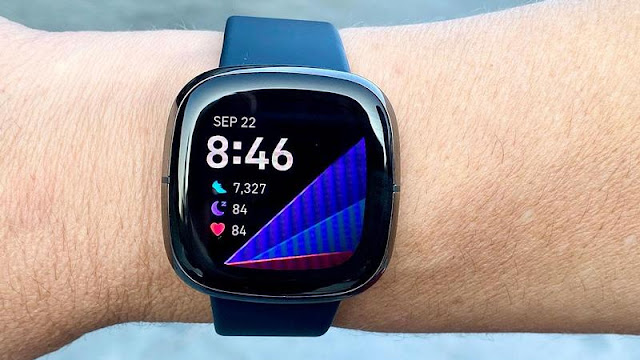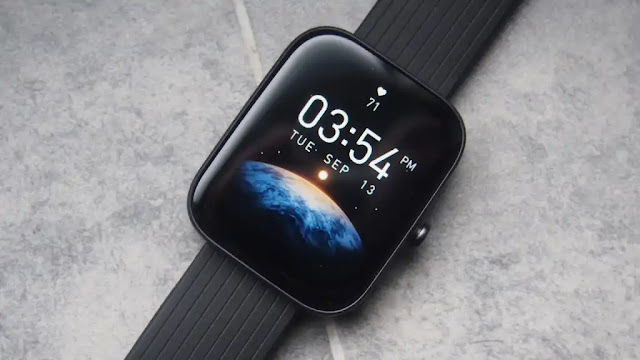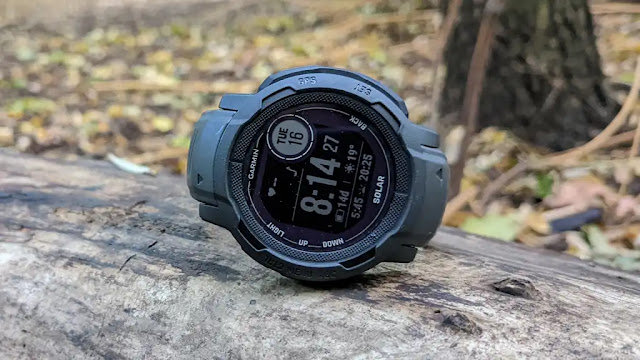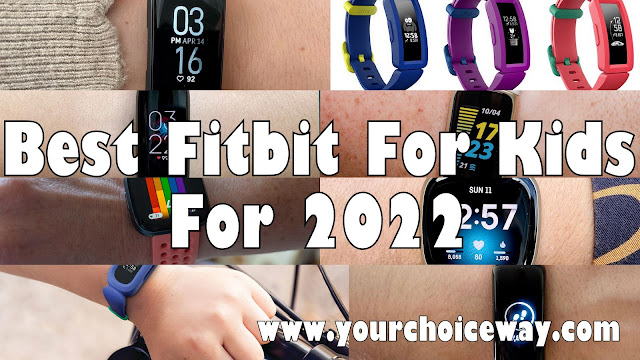Fitbit's top-end smartwatch boasts many new health features, such as ECG, EDA, skin temperature and SP02 sensors.
Should I Buy The Fitbit Sense?
Pros
- So many health and fitness features
- Great design and display
- Fitbit app
Cons
- Some metrics for paying Premium subscribers only
Our Verdict
Price When Reviewed
- $329.95
The Fitbit Sense replaces the Ionic at the top end of the family of fitness and health smart-watches and activity trackers.
Fitbit calls the Sense an “advanced health smartwatch”, and it’s on health that it beats other Fitbits, such as the Versa 3 that otherwise match it on core fitness features.
The Sense is priced at £299, US$329, A$499, €329, compared to the Versa 3 (£199, US$229, A$399, €229).
We’ll see below, what extra functions you get with the top-of-the-range Sense.
The Ionic, like the Fitbit Surge that it replaced, was marketed as a sports smartwatch. Sports was regarded as the pinnacle of the fitness tracker, but with the Sense Fitbit has pivoted away from sports to more of a focus on physical and mental health, as well as including all the expected fitness features.
Stress is regarded as the new hidden illness that affects millions, and is just as deadly as inactivity and obesity that activity trackers traditionally have focused on. Stress management and mindfulness are some of the key new features Fitbit is championing with the Sense.
But Fitbit isn’t pushing the sports angle as much as it did with the Ionic and Surge. Maybe it’s leaving the upper-end sports watch market to the likes of Garmin, Suunto and Polar.
Instead, the Sense aims its major new features at health.
These include an Electrodermal Activity (EDA) sensor that links to the EDA Scan app. This can indicate your body’s response to stress. Users can see a graph of their EDA responses in the Fitbit app, which tracks trends over time.
There’s also a new Skin Temperature Sensor, which can be used to indicate the onset of a fever or illness (can you think of any big ones going around?), as well as linking up with Fitbit’s existing female health tracking for menstrual phases.
There’s new monitoring of Sp02 levels (pulse oximetry), which measures the amount of oxygen in your blood. This data can be used to detect how effectively a person is breathing and how well blood is being transported throughout the body. Low levels of oxygen can result in serious symptoms such as hypoxemia.
The Fitbit Sense gives you detailed measurements of your vital signs. For example, it can track your breathing rate (average breaths per minute) alongside your resting heart rate.
The on-wrist ECG app assesses your heart for atrial fibrillation (AFib), so can detect common heart rhythm irregularities.
The Sense also offers a new first for Fitbit: Heart-Rate Notifications when it detects that your heart rate is above or below your normal threshold. This can be useful to detect bradycardia (a heart rate that is too slow) or tachycardia (a heart rate that is too fast).
And Fitbit has updated its PurePulse heart-rate sensor technology to version 2.0 with a multipath sensor improving on the previous optical sensor, and an updated algorithm.
Fitbit Premium subscribers can see their Heart-Rate Variation (HRV), the time between each heartbeat. Again, this can indicate the onset of illness, as well as fatigue and stress.
Fitbit calls the hub on the back of Sense, the Biosensor Core. This controls the skin temperature sensing, heart-rate tracking, and battery charging.
Before we go into more detail on the new health features, we should remind ourselves that the Sense has an impressive array of fitness features – indeed no other Fitbit has more than the Sense.
Of course, it tracks activities such as Steps, Distance, Floors Climbed, Active Minutes and Calories Burned.
10,000 steps is the classic default target, but try to increase this when you’re doing that every day. Fitbit wants you to move to the more scientific Active Zone Minutes metric rather than just Steps.
Floors Climbed is there to help you decide to take the hill rather than the flat road, or the stairs rather than the elevator.
Active Minutes has been improved with the Active Zone Minutes (AZM) metric that buzzes you when you enter a new Heart Rate Zone: Fat Burn, Cardio or Peak. This gives you instant notice that you have reached a target zone, and whether you need to push harder in your workout or pull back.
AZM was first seen on the Fitbit Charge 4, and has now been rolled out on most Fitbits.
Reminders To Move is a motivational nudge to get you to stop sitting down for long periods at a time. Every hour, it will remind you how many more steps you need to do to reach the minimum 250/hour. You can, of course, ignore it, but I find this a great regular motivator during the day.
Sitting still too long has been blamed for increasing your risk of gaining weight, heart dis-ease, type-2 diabetes and even cancer. It slows your metabolism, which affects the body's ability to regulate blood sugar, blood pressure and break down body fat. Get up and walk about a bit every hour.
There are over 20 exercise modes that the Sense will give you real-time stats about during your workouts. These can be set manually, or Fitbit’s SmartTrack tech can automatically recognize and record exercises such as run, bike, swim, treadmill, weights, yoga, and circuit training.
The full list of Exercise modes is Bike, Bootcamp, Circuit Training, Elliptical, Golf, Hike, Interval, Kickboxing, Martial Arts, Pilates, Run, Spinning, Stair Climber, Swim, Tennis, Treadmill, Walk, Weights, Workout, Yoga.
The Sense has GPS built-in, so you don’t need to lug your phone around with you on a run or bike ride.
It also allows you, after outdoor exercise, to check your Workout Intensity Map in the Fitbit app to see your heart rate zones throughout your mapped route, plus distance and pace by kilometre or mile.
GPS-compatible exercise modes on the Sense include Run, Bike, Walk, Treadmill, Outdoor Workout, and Hike. Other GPS activities include downhill and cross-country skiing, kayaking and surfing.
Sense includes a 6-axis gyroscope to track strokes and laps while swimming. Versa 3 does not include a gyroscope but laps for swimming will be calculated in the Fitbit app based on the distance.
The Sense, like all the latest Fitbits offers advanced sleep tracking, showing the Light, REM and Deep Sleep Stages and scores you on the quality of your sleep based on your sleeping heart rate, time spent awake, and time in sleep stages.
Score less than 60, and Fitbit rates your sleep as Poor; between 60-70 and it’s Fair; Good between 80-89, and excellent from 90-100.
Sleep is increasingly seen as a key health metric, affecting not just your mood but long-term physical and mental health.
Sleeping heart rate measurement is kept back for Fitbit Premium subscribers only, which we think is unfair.
You can log Food and Water in the app or on the Sense itself. Fitbit helps you count calories in and calories burned.
If you are interested in weight loss, sync your Fitbit account with the Fitbit Aria scales.
Exclusive Sense Features
Sitting at the top of the Fitbit feature tree, the Sense has some features you can’t get on other Fitbits. As the Sense name suggests, the new smartwatch is loaded with sensors.These are primarily based on health, rather than fitness where the Versa 3 is evenly matched.
Stress Management
Medical practitioners are increasingly warning that stress can be as dangerous as physical illness, contributing to high blood pressure, heart disease, obesity and diabetes.
Stress can include anxiety, lack of motivation, irritability and depression.
Fitbit has new tools in the Sense that can help identify stress, and therefore potentially help us recognise and manage it.
Common stress symptoms include headache, muscle tension, chest pain, fatigue, stomach upset and sleep problems.
Fitbit gives you a new Stress Management Score - exclusive to the Sense - in the app that calculates how your body is responding to stress based on your heart rate, sleep, and activity level data.
It has new features to gain this data.
Stress is not just bad for mental health. It can lead to increased blood pressure and affect our immune system, which is not advised right now!
A new EDA Scan app detects electrodermal activity (EDA), which can indicate your body’s response to stress. EDA is a measure of changes in the resistance of the skin to a small, undetectable electric current in response to sweat secretion.
You place your palm over the face of the Sense, which then detects small electrical changes in the sweat level of your skin,
EDA measures the intensity of emotion, not its state. An increase in conductance can be caused by both positive and negative emotional states. You can log your mood (stressed, calm, etc) after the EDA Scan.
A decrease indicates that you are becoming calmer and more relaxed.
Variation is shown in a graph in the Fitbit app.
Some ways of managing stress include increasing physical activity and mindfulness, which takes us back to Fitbit’s other fitness functions.
You open the Fitbit app, tap the Mindfulness tile, start a guided meditation, and then place your palm over the smartwatch screen for the length of the session. After your session is over, prompts in the mobile app let you reflect on how you feel and see if these have a positive effect on your stress levels.
You can set a weekly mindfulness goal, track daily mindful minutes and days, and see trends.
The score ranges from 1-100, with higher scores indicating your body is showing fewer physical signs of stress. It is paired with recommendations to better manage stress, such as breathing exercises.
Fitbit recommends and provides the tools for mindfulness, sleep mediation, breathing techniques and guided workouts.
Fitbit Premium members will get a detailed breakdown on how the score is calculated, which consists of over 10 biometric inputs, including exertion balance (impact of activity), responsiveness (heart rate, heart rate variability and electrodermal activity from the EDA Scan app), and sleep patterns (sleep quality).
Premium costs £7.99 or US$9.99 per month. The company says it has over 500,000 subscribers.
In our opinion, Fitbit shouldn’t keep back metrics to paying customers, but leave Premium for the extended on-screen and app workout and mindfulness options, and one-on-one health coaching.
Skin Temperature
A new sensor for Fitbit, is the Skin Temperature sensor. Skin temperature can indicate stress intensity, and detect changes that may potentially be a sign of a fever or illness. This is done at night, when the Sense will measure your skin temperature variation to see trends.
Skin temperature is available only in the Fitbit app and displays variation, not one-off readings.
It takes the Sense three nights to calculate your baseline skin temperature. You then see nightly average variation compared to that baseline temperature on the Temperature tile on the Today screen in the Fitbit app.
All Fitbit smartwatches can give you new insight into your nightly average SpO2 levels – the amount of oxygen in your blood.
You can also set a special SpO2 clock face to show both your previous night’s SpO2 range and nightly average.
It tracks your oxygen saturation levels while you sleep, so is not as advanced as the SP02 sensor on the Apple Watch that takes a blood O2 reading in just 15 seconds at any time of day.
In September, Fitbit received US FDA and EU CE accreditation for its electrocardiogram (ECG) app. In October, you can get a reading by opening the ECG app and placing your index finger and thumb on the opposite corners of the metal frame for 30 seconds.
The ECG app assesses your heart for heart rhythm irregularity - atrial fibrillation or AFib that increases the risk of serious complications like stroke.
An algorithm detects AFib from normal sinus rhythm and generates an ECG trace, or recording of a heart’s electrical rhythm.
For Fitbit Premium subscribers only, a new Health Metrics dashboard tracks your 7- and 30-day trends for new metrics like heart-rate variability, breathing rate per minute, oxygen saturation, and skin temperature variation.
Fitbit Sense Notifications, Alarms And Apps
The most used apps on fully featured smartwatches, such as the Apple Watch and Samsung Gear, are on-wrist notifications.
While the Fitbit smartwatches are no match for a wide range of apps, they do notifications very well. Notifications for calls, texts, calendar events and apps such as WhatsApp, Gmail and Facebook are included.
Android users can also send quick replies and voice replies right from your wrist when your phone is nearby. Apple keeps these Reply functions exclusively for its own Watch, so you can’t blame Fitbit for this missing iPhone function.
Also handy are silent alarms that buzz on your wrist, supposedly without waking your bed partner – although if used with a metal strap I can confirm that the buzz can be audible to others.
Smart Alarm is a setting that lets you wake up at the best time during your sleep cycle (during Light sleep), up to half an hour earlier but no later.
There are two timers: Countdown and Stopwatch.
A Weather app gives you a forecast for today and the next two days.
Other apps include Relax that offers two- and five-minute Guided Breathing sessions that are personalised based on your heart rate.
Agenda is a calendar app. Wallet is contactless Fitbit Pay. Spotify and Deezer are for music control.
You can also download apps for fitness and sports, but also for services such as Uber, Spotify and airlines.
While the Apple Watch offers Apple’s Siri, the Fitbit Sense will boast a choice of two voice assistants: either Amazon’s Alexa or Google Assistant. We will have to wait for Google Assistant, though, as it’s not coming till “late 2020”. With Google set to buy Fitbit, it’s an obvious addition, as are the Android-only features.
Also coming soon are Audible Replies, where Alexa and Google Assistant will be able to respond back to you with audible replies through the Sense’s built-in speaker.
Even more exciting, the speaker and microphone will later let users take calls directly from the watch when their phone is nearby. Android users will be able to respond to text messages on-the-go with voice-to-text commands.
The Sense pebble (the tracker case excluding the strap) is made of aluminium with a polished (medical-grade) stainless steel finish. This high-quality stainless steel ring is reuired to get the ECG and EDA readings. It’s also more durable; the medical-grade refers to its corrosion resistance.
The Versa 3 pebble lacks the stainless-steel ring but is otherwise pretty identical.
Even though visually it seems a little smaller, Sense is slightly larger than the Versa 2, and features a bigger OLED display with a higher resolution. Its 1.58in display has a resolution of 336-x-336 pixels - compared to the Versa 2’s 1.39in display with a resolution of 300-x-300 pixels.
The dimension of the Sense pebble is 40.48-x-40.48-x-12.35mm compared to Versa 2’s dimensions of 39.95-x-39.84-x-12.15mm.
The Sense is about 5g heavier than the Versa 3 - not a difference that you will notice.
The physical button found on the Versa 2 is replaced with a new haptic one on the left edge.
There’s a new swappable strap type (called the Infinity Band), and it takes a little getting used to. Instead of the classic watch-type strap, there’s a peg you push through the best hole for your fit, and then close it through a loop.
During workouts, Fitbit recommends wearing it higher on your wrist for a better fit.
The Fitbit Sense is available in Graphite Stainless Steel with Carbon band, or Soft Gold Stainless Steel and Lunar White band.
Fitbit Sense Accessories
As we’ve grown accustomed to, Fitbit sees its activity trackers and smartwatches as not just fitness and health devices but fashion items.
Accessory straps include woven bands in Charcoal, Coral, Camo and Rainbow colours; and Knit in Gold/Black, Black/Red, and Red/Gold.
There are silicone Sports bands in Melon/Rose, Grey/Mint, Sapphire/Fog Grey, Black/Lunar White and Evergreen/Lunar White.
There are four Horween Leather bands in Perforated Charcoal, Black, Walnut and Poppy.
There’s also a range of Pendleton bands made from recycled plastic fibres, including a Blue/Black Basket Maker pattern and Blue/Grey Canyonlands.
Woven and Sports bands cost £29.99 / $34.95 / €34.95; Knit and Pendleton for £34.99 / $39.95 / €39.95; Leather for £49.99 / $49.95 / €49.95.
Fitbit Sense User Interface And Navigation
The bright new Fitbit user interface is great and nicely customisable.
You can choose from a wide range of clock faces (store up to five on the watch at one time), and then swipe for data.
Swipe down for Core Stats (Steps, Floors, Distance, Calories Burned, Active Zone Minutes), Advanced Stats (Heart Rate, Hourly Activity, Exercise, Sleep and Food/Water logs), the three-day Weather app, to view the latest text, EDA Scan, and Guided Sessions. You can also swipe down for your most recent call and app Notifications.
Swipe left for EDA Scan, the Today Screen (Core and Advanced Stats, Water and Weight, plus the chance to log your temperature using a thermometer, not via the Sense), set your Exercise mode (see above), watch Settings, Alarms, Timer, Spotify and more.
Swipe right to access common watch settings and modes, such as Brightness, Sleep Mode, Do Not Disturb to mute calls and notifications, Always-On Display for continual stats display during workouts and exercise with a low-power screen, Screen Wake controls, and the ability to adjust the volume for connected audio devices.
Fitbit’s claims the Sense has a battery life of 6+ days. I haven’t had the Sense that long, and will update this review when I’ve gone through a week of testing.
Of course, the battery life depends on your usage - using the GPS will burn through a battery faster than without.
The Sense features a new charger type, as we’ve come to expect from Fitbit. Remarkably, it’s the same charger as used with the Versa 3 – a first for the company.
The charger connects magnetically to the back of the Sense. I’d hoped it would connect any way round, but it fits in just one alignment.
While I like the fact that it’s smaller than the chunky Versa charger, the fact that it lies awkwardly while charging is not so great.
It takes about 2 hours to fully charge from zero, or 40 minutes from 10-80%. There’s also fast charging that will give you a day’s battery life in 12 minutes – especially useful; when you realise your watch’s battery is not going to make it through the rest of the day.
The display has a battery level indicator when charging. Frustratingly I can’t find a battery indicator when not charging, although you can see it easily in the mobile app.
The Sense adds a lot of new health features at the top-end of the Fitbit range. You could call it the hypochondriac’s smartwatch, it’s so full of warning signs, but there’s a lot here that will help indicate serious health problems that you will have the chance to improve.
Mindfulness might seem a little kooky to some and a concern for those with too much time on their hands, but there is no denying that stress can affect us all, and managing it will quickly bring not just mental but long-term physical health benefits.
If fitness is all you want an activity-tracking smartwatch for, then the cheaper Fitbit Versa 3 offers everything you’ll get in that respect with the Sense.
For all-round physical and mental health tracking, the Sense is the Fitbit with it all.
























%20Review.webp)


0 comments:
Post a Comment